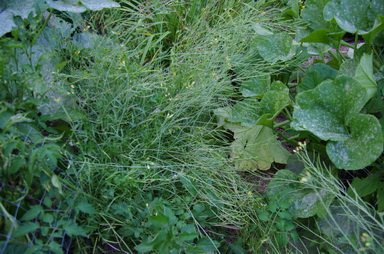| Back to Back Issues Page |
 |
|
Dallying In The Dirt, Issue #185 --- New purple Sedums are earning their keep. August 29, 2014 |

Wow! I can’t believe how many of you seized upon the Ground Ivy fix. Apparently it bothers others as much as it bothers me. I need to provide a few caveats. It works because Creeping Charlie is ultra sensitive to Boron. Many plants find Boron toxic at some level so you must be careful. Apply it only to turf grass areas and only at the recommended rates. The research I was reading about it, also indicated that it would be unwise to do it more than two years in a row. Boron leaches out of the soil very slowly and you could build it up to levels toxic to the turf if the treatment was overdone. My grass is growing better than ever in the small area where I killed the Ground Ivy. Will do the rest next week. Emptied the container of Potatoes today and found a reasonable harvest, not my biggest, but still quite acceptable. There was limited sunshine and hot weather this summer and although that made
watering less of a chore, it also reduced the harvest. French Fingerling is my favourite variety for growing in containers. The Purple Viking that I like in the garden does very poorly in a container. Purple Viking tends to produce a few large tubers while French Fingerling produces a larger quantity of small potatoes and that’s why it does so well in a pot.  September is going to show up on Monday and the perennial beds are changing every day. The last of the Lilies and the Daylilies have faded and the Phlox and Sedums are starting to take centre stage. I was a bit disappointed this week when one of my entries in the local flower show did not even get a fourth place. It was a perfect stem of Solidago canadensis which I intentionally grow for its brilliant yellow fall colour. I think the judge just saw a piece of Goldenrod and thought I was entering a weed. I have seen it have a bed of its own, in grand gardens like Sissinghurst. It does have a totally undeserved reputation as an allergen, which it cannot be since it doesn’t have a wind borne pollen. I have collected a few new Sedums over the last years and I have been having trouble accepting the value of some of the purple foliage types. They seem
to have a tendency to flop. This year, a couple of them, having become more established, are standing straight and tall and putting on a great show of coloured stems, leaves and flowers. They are earning their place in the autumn garden.
September is going to show up on Monday and the perennial beds are changing every day. The last of the Lilies and the Daylilies have faded and the Phlox and Sedums are starting to take centre stage. I was a bit disappointed this week when one of my entries in the local flower show did not even get a fourth place. It was a perfect stem of Solidago canadensis which I intentionally grow for its brilliant yellow fall colour. I think the judge just saw a piece of Goldenrod and thought I was entering a weed. I have seen it have a bed of its own, in grand gardens like Sissinghurst. It does have a totally undeserved reputation as an allergen, which it cannot be since it doesn’t have a wind borne pollen. I have collected a few new Sedums over the last years and I have been having trouble accepting the value of some of the purple foliage types. They seem
to have a tendency to flop. This year, a couple of them, having become more established, are standing straight and tall and putting on a great show of coloured stems, leaves and flowers. They are earning their place in the autumn garden.Now it’s time to answer a few of my reader’s questions. Don’t forget to check the front page of the Website for frequent short ideas for current gardening activities. Ken Answers! There were several question about the Borax treatment and I hope I answered them all at the top. Richard Asks?
Quick question, my hosta is being eaten by someone and I keep looking to see something and nothing is there...spots of brown in the middle of pretty much every leaf? Mostly on my variegated variety. Someone suggested it's slugs, however I haven't seen any signs of them. |
| Back to Back Issues Page |
 Arugula, it’s a delightful addition to salads and it tastes much better than it smells. I planted a bit of it this year and I know that I will learn to regret it. I’ve picked many handfuls for salads and stir fry flavouring. I also was growing another variety called Wasabi Arugula and when you eat a leaf of it, that distinctive pungent flavour does come through rather noticeably. I have been very good about keeping it cut back all summer so it has been a contained decorative addition to the garden with its white flowers. Down in the bottom end I have not been as diligent with the regular Arugula and I fear that I will pay dearly for my inattentiveness. It has taken over a significant portion of the garden and it is covered with ripening seed pods. It will self seed quite happily and I’m sure I will have a lifetime supply of Arugula growing in most of the bottom half of the garden. Cutting it back when it starts to flower is one of those jobs that can always be done
tomorrow.
Arugula, it’s a delightful addition to salads and it tastes much better than it smells. I planted a bit of it this year and I know that I will learn to regret it. I’ve picked many handfuls for salads and stir fry flavouring. I also was growing another variety called Wasabi Arugula and when you eat a leaf of it, that distinctive pungent flavour does come through rather noticeably. I have been very good about keeping it cut back all summer so it has been a contained decorative addition to the garden with its white flowers. Down in the bottom end I have not been as diligent with the regular Arugula and I fear that I will pay dearly for my inattentiveness. It has taken over a significant portion of the garden and it is covered with ripening seed pods. It will self seed quite happily and I’m sure I will have a lifetime supply of Arugula growing in most of the bottom half of the garden. Cutting it back when it starts to flower is one of those jobs that can always be done
tomorrow.